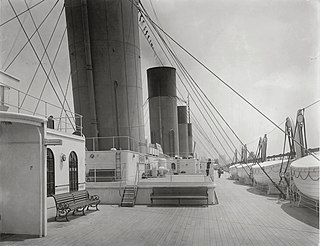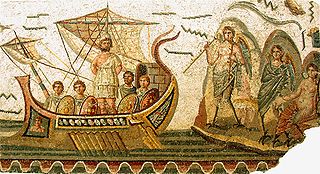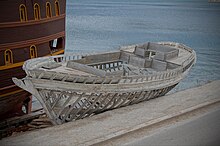
A hull is the watertight body of a ship, boat, or flying boat. The hull may open at the top, or it may be fully or partially covered with a deck. Atop the deck may be a deckhouse and other superstructures, such as a funnel, derrick, or mast. The line where the hull meets the water surface is called the waterline.

Longships were a type of specialised Scandinavian warships that have a long history in Scandinavia, with their existence being archaeologically proven and documented from at least the fourth century BC. Originally invented and used by the Norsemen for commerce, exploration, and warfare during the Viking Age, many of the longship's characteristics were adopted by other cultures, like Anglo-Saxons, and continued to influence shipbuilding for centuries.

Naval architecture, or naval engineering, is an engineering discipline incorporating elements of mechanical, electrical, electronic, software and safety engineering as applied to the engineering design process, shipbuilding, maintenance, and operation of marine vessels and structures. Naval architecture involves basic and applied research, design, development, design evaluation (classification) and calculations during all stages of the life of a marine vehicle. Preliminary design of the vessel, its detailed design, construction, trials, operation and maintenance, launching and dry-docking are the main activities involved. Ship design calculations are also required for ships being modified. Naval architecture also involves formulation of safety regulations and damage-control rules and the approval and certification of ship designs to meet statutory and non-statutory requirements.

The bilge of a ship or boat is the part of the hull that would rest on the ground if the vessel were unsupported by water. The "turn of the bilge" is the transition from the bottom of a hull to the sides of a hull.
Shipbuilding is the construction of ships and other floating vessels. It normally takes place in a specialized facility known as a shipyard. Shipbuilders, also called shipwrights, follow a specialized occupation that traces its roots to before recorded history.

Liberty ships were a class of cargo ship built in the United States during World War II under the Emergency Shipbuilding Program. Although British in concept, the design was adopted by the United States for its simple, low-cost construction. Mass-produced on an unprecedented scale, the Liberty ship came to symbolize U.S. wartime industrial output.

The keel is the bottom-most longitudinal structural element on a watercraft. On some sailboats, it may have a hydrodynamic and counterbalancing purpose, as well. The laying of the keel is often the initial step in the construction of a ship. In the British and American shipbuilding traditions, this event marks the beginning date of a ship's construction.

Boat building is the design and construction of boats and their systems. This includes at a minimum a hull, with propulsion, mechanical, navigation, safety and other systems as a craft requires.

A deck is a permanent covering over a compartment or a hull of a ship. On a boat or ship, the primary or upper deck is the horizontal structure that forms the "roof" of the hull, strengthening it and serving as the primary working surface. Vessels often have more than one level both within the hull and in the superstructure above the primary deck, similar to the floors of a multi-storey building, that are also referred to as decks, as are certain compartments and decks built over specific areas of the superstructure. Decks for some purposes have specific names.
This glossary of nautical terms is an alphabetical listing of terms and expressions connected with ships, shipping, seamanship and navigation on water. Some remain current, while many date from the 17th to 19th centuries. The word nautical derives from the Latin nauticus, from Greek nautikos, from nautēs: "sailor", from naus: "ship".

Clinker built is a method of boat building in which the edges of hull planks overlap each other. Where necessary in larger craft, shorter planks can be joined end to end, creating a longer strake or hull plank.

On a vessel's hull, a strake is a longitudinal course of planking or plating which runs from the boat's stempost to the sternpost or transom. The garboard strakes are the two immediately adjacent to the keel on each side.

The stern is the back or aft-most part of a ship or boat, technically defined as the area built up over the sternpost, extending upwards from the counter rail to the taffrail. The stern lies opposite the bow, the foremost part of a ship. Originally, the term only referred to the aft port section of the ship, but eventually came to refer to the entire back of a vessel. The stern end of a ship is indicated with a white navigation light at night.
Ancient boat building methods can be categorized as one of hide, log, sewn, lashed-plank, clinker, shell-first, and frame-first. While the frame-first technique dominates the modern ship construction industry, the ancients relied primarily on the other techniques to build their watercraft. In many cases, these techniques were very labor-intensive and/or inefficient in their use of raw materials. Regardless of differences in ship construction techniques, the vessels of the ancient world, particularly those that plied the waters of the Mediterranean Sea and the islands of Southeast Asia were seaworthy craft, capable of allowing people to engage in large-scale maritime trade.

The Sparrow-Hawk was a 'small pinnace' similar to the full-rigged pinnace Virginia that sailed for the English Colonies in June 1626. She is the earliest ship to participate in the first decades of English settlement in the New World to have survived to the present day.
Longitudinal framing is a method of ship construction in which large, widely spaced transverse frames are used in conjunction with light, closely spaced longitudinal members. This method, Isherwood felt, lent a ship much greater longitudinal strength than in ships built in the traditional method, where a series of closely spaced transverse frames are fitted from the keel to the sheer line, with corresponding deck beams, a method that is well suited to support longitudinal planking.

Discovered by divers from the French Navy Diving School in 1967, the archaeological investigations of the Roman wreck at Madrague de Giens constituted the first large scale, "truly scientific underwater excavation[s] carried out in France". The wreck lies at around 18 to 20 metres depth off the coast of the small fishing port of La Madrague de Giens on the Giens Peninsula, east of Toulon, on the southern Mediterranean coast of France. Sunk around 75–60 BCE, the vessel has been found to be "a large merchantman of considerable tonnage—400 tons deadweight with a displacement of around 550 tons", making it one of the largest Roman wrecks excavated, with only the wreck at Albenga, Italy exceeding it at the time of its discovery. The vessel wrecked at Madrague de Giens measured around 40 metres in length; "showed a sharp bottom with "wine glass" section and a prominent keel creating a large leeboard"; displayed extended raking of the stem and stern; and had two masts. The hull was characterised by a reverse stempost in the shape of a ram with a big cutwater which "must have given... [the] craft high-performance sailing qualities". The ship sank while transporting a large cargo of wine and black glazed pottery from Italy. It is not known why it sank.

The SB Kathleen was a spritsail Thames barge built by Glover at Gravesend, Kent, in England in 1901, and registered in Rochester. Her official number was 113,708. She was built to carry grain- for capacity rather than speed. she was 82.8 feet (25.2 m) long and had a beam of 19.7 feet (6.0 m). Light, she drew 30 inches (76 cm) of water, and laden 6 feet (1.8 m).

On a vessel's hull, a rib is a lateral structural member which runs between gunwales and sprouts from the keel. They are called "ribs" because they resemble the human rib. The ship's outer planking and inner sheathing are attached to the ribs. For ships that are too large for a rib to be made out of a single piece of wood, the ribs are made of multiple sections called futtocks that are scarfed together. The ancient writers Polybius and Plato held that, since the ribs of a ship were the most important part of the ship's framework, then if the ribs were new, then the ship as a whole was new. Iron was first used in shipbuilding to make the ribs and frames, with wood sheathing attached to them, but this proved inadequate compared to replacing the wood sheathing with iron plates.
This glossary of nautical terms is an alphabetical listing of terms and expressions connected with ships, shipping, seamanship and navigation on water. Some remain current, while many date from the 17th to 19th centuries. The word nautical derives from the Latin nauticus, from Greek nautikos, from nautēs: "sailor", from naus: "ship".















